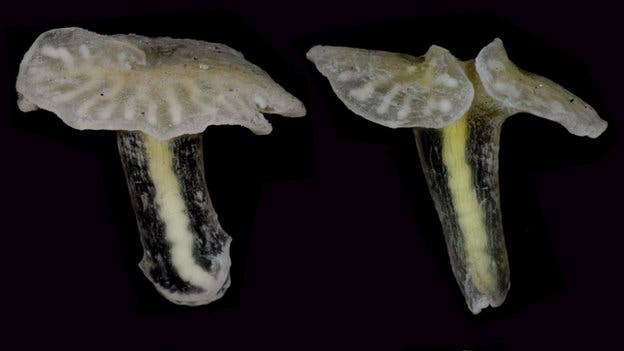
A team of scietists from the University of Copenhagen have found a mushroom shaped animal which they believe doesn’t fit in any known subdivision of the animal kingdom. Such a situation has happened only a few times in the past 100 years.
Researchers aren’t exactly sure where to fit it, but they have a pretty good idea. It’s a multicellular organism, probably related to the jellyfish. What’s even more interesting about them is that they are very similar to strange and poorly understood organisms which inhabited the Earth between 635 and 540 million years ago – in what is called the Ediacaran period. The Ediacaran fauna has is also highly debated and not yet fitted into a clear category of life.
Measuring only a few millimetres in size, the animals consist of a flattened disc and a stalk with a mouth on the end.
The samples were obtained in 1986, over 20 years ago. It’s not uncommon for samples to reach this old age before being thoroughly analyzed, and it’s one of the reasons why the organisms are so hard to classify. If someone were to take newer samples, those would almost certainly prove easier to classify. The samples were preserved in alcohol, which destroys DNA and makes DNA testing somewhere between very difficult and impossible.
“Finding something like this is extremely rare, it’s maybe only happened about four times in the last 100 years,” said co-author Jorgen Olesen from the University of Copenhagen. “We think it belongs in the animal kingdom somewhere; the question is where.”
“What we can say about these organisms is that they do not belong with the bilateria,” said Dr Olesen.
Bilateria are animals with bilateral symmetry, i.e. they have a front and a back end, as well as an upside and downside, and therefore a left and a right. In contrast, radially symmetrical animals like jellyfish have a topside and downside, but no front and back. These new animals could easily be a new branch in the tree of life or an intermediate between two different animal phyla.

Researchers are asking others to look through their collections and see if they have any other samples, which would perhaps be suitable for DNA analysis.
“We published this paper in part as a cry for help,” said Dr Olesen. “There might be somebody out there who can help place it.”
Journal Reference: Jean Just, Reinhardt Møbjerg Kristensen, Jørgen Olesen. Dendrogramma, New Genus, with Two New Non-Bilaterian Species from the Marine Bathyal of Southeastern Australia (Animalia, Metazoa incertae sedis) – with Similarities to Some Medusoids from the Precambrian Ediacara. DOI: 10.1371/journal.pone.0102976
Was this helpful?



